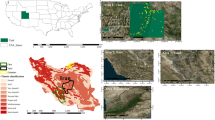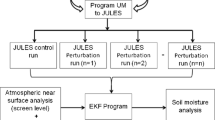Abstract
Microwave remote sensing and mesoscale weather models have high potential to monitor global hydrological processes. The latest satellite soil moisture dedicated mission SMOS and WRF-NOAH Land Surface Model (WRF-NOAH LSM) provide a flow of coarse resolution soil moisture data, which may be useful data sources for hydrological applications. In this study, four data fusion techniques: Linear Weighted Algorithm (LWA), Multiple Linear Regression (MLR), Kalman Filter (KF) and Artificial Neural Network (ANN) are evaluated for Soil Moisture Deficit (SMD) estimation using the SMOS and WRF-NOAH LSM derived soil moisture. The first method (and most simplest) utilizes a series of simple combinations between SMOS and WRF-NOAH LSM soil moisture products, while the second uses a predictor equation generally formed by dependent variables (Probability Distributed Model based SMD) and independent predictors (SMOS and WRF-NOAH LSM). The third and fourth techniques are based on rigorous calibration and validation and need proper optimisation for the final outputs backboned by strong non-linear statistical analysis. The performances of all the techniques are validated against the probability distributed model based soil moisture deficit as benchmark; estimated using the ground based observed datasets. The observed high Nash Sutcliffe Efficiencies between the fused datasets with Probability Distribution Model clearly demonstrate an improved performance from the individual products. However, the overall analysis indicates a higher capability of ANN and KF for data fusion than the LWA or MLR approach. These techniques serve as one of the first demonstrations that there is hydrological relevant information in the coarse resolution SMOS satellite and WRF-NOAH LSM data, which could be used for hydrological applications.









Similar content being viewed by others
References
Alley WM (1984) The Palmer drought severity index: limitations and assumptions. J Clim Appl Meteorol 23(7):1100–1109
Al-Shrafany D, Rico-Ramirez MA, Han D, Bray M (2013) Comparative assessment of soil moisture estimation from land surface model and satellite remote sensing based on catchment water balance. Meteorol Appl. doi:10.1002/met.1357
Anderson JA (1995) An introduction to neural networks, vol 1. MIT Press, Cambridge MA, p 650
Anderson B, Moore J (1979) Optimal filtering. Prentice-Hall, Englewood Cliffs
Bell V, Moore R (1998) A grid-based distributed flood forecasting model for use with weather radar data: Part 2. Case studies. Hydrol Earth Syst Sci 2(2/3):283–298
Cabus P (2008) River flow prediction through rainfall–runoff modelling with a probability-distributed model (PDM) in Flanders, Belgium. Agric Water Manag 95(7):859–868
Calder I, Harding R, Rosier P (1983) An objective assessment of soil-moisture deficit models. J Hydrol 60(1–4):329–355
Chen F, Dudhia J (2001) Coupling an advanced land surface-hydrology model with the Penn State-NCAR MM5 modeling system. Part I: Model implementation and sensitivity. Mon Weather Rev 129(4):569–585
Dornfeld DA, DeVries M (1990) Neural network sensor fusion for tool condition monitoring. CIRP Ann Manuf Technol 39(1):101–105
Gupta M, Garg N, Joshi H, Sharma M (2012) Persistence and mobility of 2, 4-D in unsaturated soil zone under winter wheat crop in sub-tropical region of India. Agric Ecosyst Environ 146(1):60–72
Helske J (2010) KFAS: Kalman filter and smoothers for exponential family state space models. R package version 06 0, URL http://CRAN.R-projectorg/package=KFAS
Hogue TS, Bastidas L, Gupta H, Sorooshian S, Mitchell K, Emmerich W (2005) Evaluation and transferability of the Noah land surface model in semiarid environments. J Hydrometeorol 6(1):68–84
Hong S, Lakshmi V, Small EE, Chen F, Tewari M, Manning KW (2009) Effects of vegetation and soil moisture on the simulated land surface processes from the coupled WRF/Noah model. J Geophys Res 114(D18), D18118
Ishak A, Remesan R, Srivastava P, Islam T, Han D (2013) Error correction modelling of wind speed through hydro-meteorological parameters and mesoscale model: a hybrid approach. Water Resour Manag 27(1):1–23. doi:10.1007/s11269-012-0130-1
Islam T, Rico-Ramirez MA, Han D, Bray M, Srivastava PK (2012) Fuzzy logic based melting layer recognition from 3 GHz dual polarization radar: appraisal with NWP model and radio sounding observations. Theor Appl Climatol 112(1–2):317–338
Jackson TJ, Le Vine DM, Hsu AY, Oldak A, Starks PJ, Swift CT, Isham JD, Haken M (1999) Soil moisture mapping at regional scales using microwave radiometry: the Southern Great Plains Hydrology Experiment. Geosci Remote Sens IEEE Trans 37(5):2136–2151
Johnson RA, Wichern DW (2002) Applied multivariate statistical analysis, vol 4. Prentice Hall, Upper Saddle River
Kerr YH, Waldteufel P, Wigneron JP, Martinuzzi J, Font J, Berger M (2001) Soil moisture retrieval from space: the Soil Moisture and Ocean Salinity (SMOS) mission. Geosci Remote Sens IEEE Trans 39(8):1729–1735
Kerr YH, Waldteufel P, Richaume P, Wigneron JP, Ferrazzoli P, Mahmoodi A, Al Bitar A, Cabot F, Gruhier C, Juglea SE (2012) The SMOS soil moisture retrieval algorithm. Geosci Remote Sens IEEE Trans 50(5):1384–1403
Koopman SJ (2012) Time series analysis by state space methods, vol 38. Oxford University Press, Oxford, p 346
Koopman SJ, Durbin J (2000) Fast filtering and smoothing for multivariate state space models. J Time Ser Anal 21(3):281–296
Koopman SJ, Durbin J (2003) Filtering and smoothing of state vector for diffuse state–space models. J Time Ser Anal 24(1):85–98
Kutner MH, Nachtsheim C, Neter J (2004) Applied linear regression models. McGraw-Hill/Irwin; 5th edn (August 10, 2004), p 1396
Li XR, Zhu Y, Wang J, Han C (2003) Optimal linear estimation fusion. I. Unified fusion rules. Inf Theory IEEE Trans 49(9):2192–2208
Liu J, Han D (2010) Indices for calibration data selection of the rainfall-runoff model. Water Resour Res 46(4), W04512
Michalakes J, Chen S, Dudhia J, Hart L, Klemp J, Middlecoff J, Skamarock W (2001) Development of a next generation regional weather research and forecast model. In: Developments in Teracomputing: Proceedings of the Ninth ECMWF Workshop on the use of high performance computing in meteorology. World Scientific, pp 269–276
Mohan M, Bhati S (2011) Analysis of WRF model performance over subtropical region of Delhi, India. Adv Meteorol 2011:13. doi:10.1155/2011/621235
Moody J, Hanson S, Krogh A, Hertz JA (1995) A simple weight decay can improve generalization. Adv Neural Inf Process Syst 4:950–957
Moore R (2007) The PDM rainfall-runoff model. Hydrol Earth Syst Sci 11(1):483–499
Nash JE, Sutcliffe J (1970) River flow forecasting through conceptual models part I—a discussion of principles. J Hydrol 10(3):282–290
Noilhan J, Planton S (1989) A simple parameterization of land surface processes for meteorological models. Mon Weather Rev 117(3):536–549
Norbiato D, Borga M, Degli Esposti S, Gaume E, Anquetin S (2008) Flash flood warning based on rainfall thresholds and soil moisture conditions: an assessment for gauged and ungauged basins. J Hydrol 362(3):274–290
Pan H-L, Mahrt L (1987) Interaction between soil hydrology and boundary-layer development. Bound-Layer Meteorol 38(1):185–202
RDevelopment C (2010) TEAM. 2006. R: a language and environment for statistical computing. R Foundation for Statistical Computing, Vienna, Austria. ISBN 3-900051-07-0, URL http://www.R-project.org
Rees HG, Collins DN (2006) Regional differences in response of flow in glacier–fed Himalayan rivers to climatic warming. Hydrol Process 20(10):2157–2169
Saleh K, Wigneron J-P, De Rosnay P, Calvet J-C, Escorihuela MJ, Kerr Y, Waldteufel P (2006) Impact of rain interception by vegetation and mulch on the L-band emission of natural grass. Remote Sens Environ 101(1):127–139
Schaake JC, Koren VI, Duan Q-Y, Mitchell K, Chen F (1996) Simple water balance model for estimating runoff at different spatial and temporal scales. J Geophys Res D Atmos 101:7461–7475
Shumway RH, Stoffer DS, Stoffer DS (2000) Time series analysis and its applications, vol 549. Springer, New York
Skamarock WC, Klemp JB (2008) A time-split nonhydrostatic atmospheric model for weather research and forecasting applications. J Comput Phys 227(7):3465–3485
Srivastava PK, Han D, Rico-Ramirez MA (2012a) Assessment of SMOS satellite derived soil moisture for soil moisture deficit stimation. Symposium on Prediction in Ungauged basin (PUBS) co-organized by Delft University of Technology, Delft, Netherlands and International Association of Hydrological Sciences (IAHS) dated 22–25 October 2012:1
Srivastava PK, Han D, Rico-Ramirez MA, Bray M, Islam T (2012b) Selection of classification techniques for land use/land cover change investigation. Adv Space Res 50(9):1250–1265. doi:10.1016/j.asr.2012.06.032
Srivastava PK, Han D, Ramirez MR, Islam T (2013a) Machine learning techniques for downscaling SMOS satellite soil moisture using MODIS land surface temperature for hydrological application. Water Resour Manag 27(8):3127–3144. doi:10.1007/s11269-013-0337-9
Srivastava PK, Han D, Rico-Ramirez MA (2013b) Data fusion techniques for an improved soil moisture retrieval using SMOS and WRF-NOAH Land surface model SMOS land application workshop, ESA-ESRIN, Frascati, Italy 25–27 February 2013
Srivastava PK, Han D, Rico-Ramirez MA, Islam T (2013c) Sensitivity and uncertainty analysis of mesoscale model downscaled hydro-meteorological variables for discharge prediction. Hydrol Process. doi:10.1002/hyp.9946
Srivastava PK, Han D, Rico Ramirez MA, Islam T (2013d) Appraisal of SMOS soil moisture at a catchment scale in a temperate maritime climate. J Hydrol. doi:10.1016/j.jhydrol.2013.06.021
Srivastava PK, Han D, Rico Ramirez MA, Islam T (2013e) Comparative assessment of evapotranspiration derived from NCEP and ECMWF global datasets through Weather Research and Forecasting model. Atmos Sci Lett 14(2):118–125. doi:10.1002/asl2.427
Stathaki T (2008) Image fusion: algorithms and applications. Academic Press, London, p 520
Sun S-l (2004) Multi-sensor optimal information fusion Kalman filters with applications. Aerosp Sci Technol 8(1):57–62
Taylor KE (2001) Summarizing multiple aspects of model performance in a single diagram. J Geophys Res 106(D7):7183–7192
Zhang G, Eddy Patuwo B, Hu MY (1998) Forecasting with artificial neural networks: the state of the art. Int J Forecast 14(1):35–62
Acknowledgments
The authors would like to thank the Commonwealth Scholarship Commission, British Council, United Kingdom and Ministry of Human Resource Development, Government of India for providing the necessary support and funding for this research. The authors would like to acknowledge the British Atmospheric Data Centre and Environment Agency, United Kingdom for providing the ground datasets. The author also acknowledges the Advanced Computing Research Centre at University of Bristol for providing the access to the supercomputer facility (The Blue Crystal) and Linux R support.
Author information
Authors and Affiliations
Corresponding author
Rights and permissions
About this article
Cite this article
Srivastava, P.K., Han, D., Rico-Ramirez, M.A. et al. Data Fusion Techniques for Improving Soil Moisture Deficit Using SMOS Satellite and WRF-NOAH Land Surface Model. Water Resour Manage 27, 5069–5087 (2013). https://doi.org/10.1007/s11269-013-0452-7
Received:
Accepted:
Published:
Issue Date:
DOI: https://doi.org/10.1007/s11269-013-0452-7




